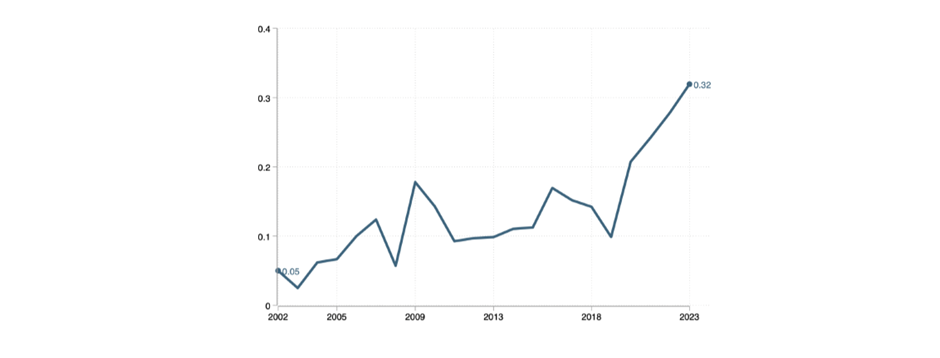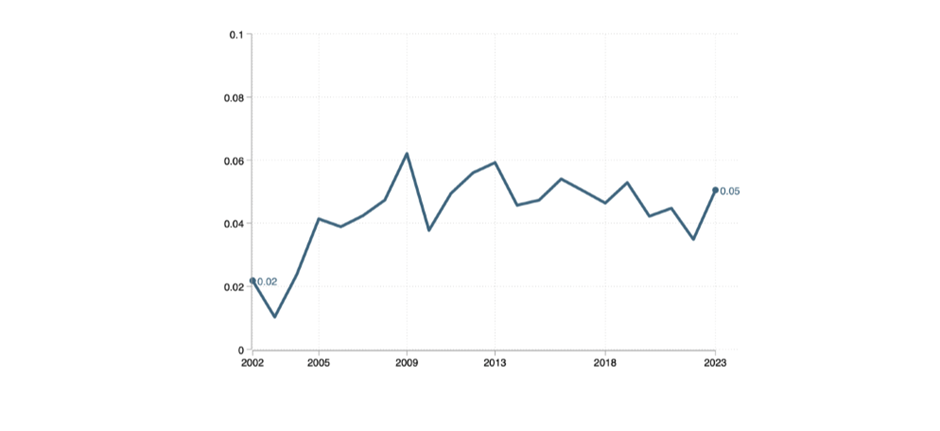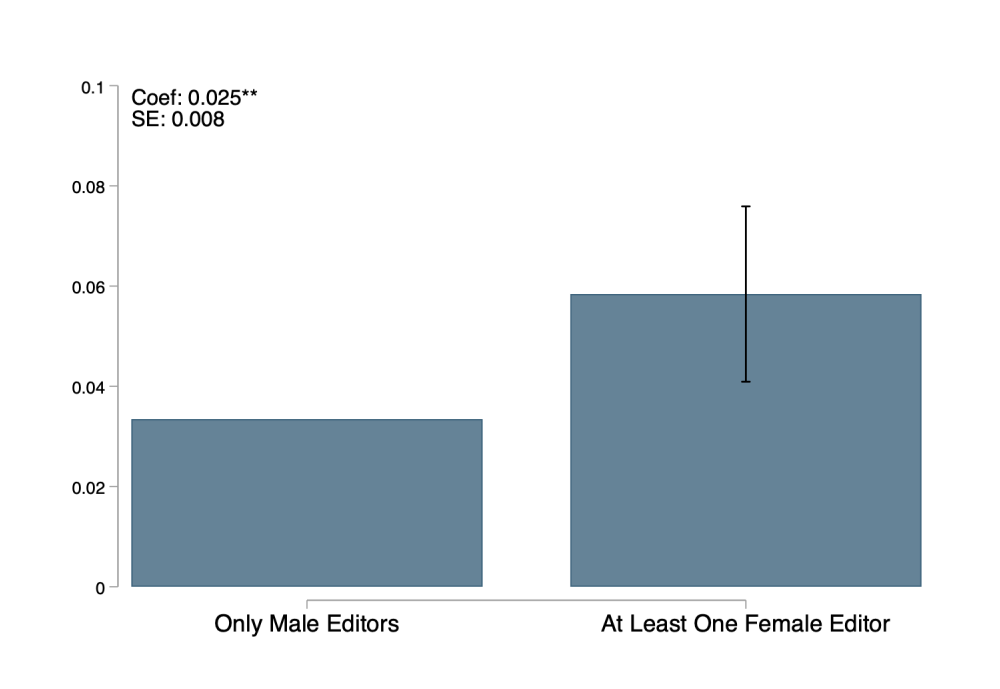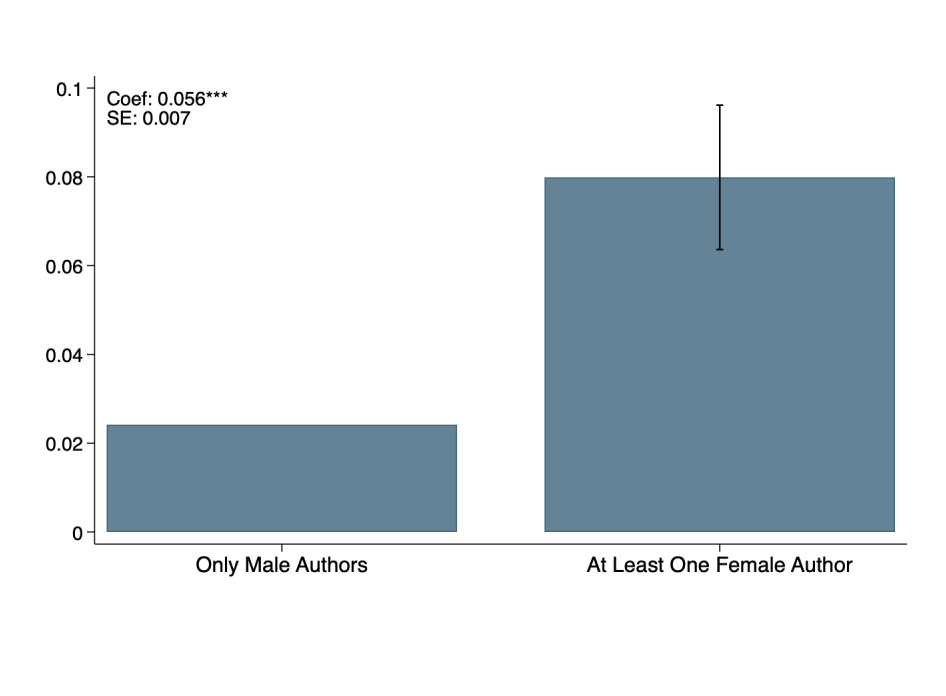
How does having more women on the editorial boards of top economics journals influence what gets published? A new analysis reveals that as female representation on editorial boards rises, more women-authored papers are being published and there is an increased focus on gender-related research.
The proportion of women earning economics PhDs at US institutions rose from 27% to 34% between 2000 and 2020, while their representation in tenure-track positions increased from 18% to 27% (Chevalier 2021). Female editorship in top economic journals increased from a very low base (Anukriti 2024, Funk et al. 2024) and recent research suggests that this was associated with a rise in the share of published articles (co-)authored by women (Bransch and Kvasnicka 2022).
Here, we provide suggestive evidence that female representation on editorial boards is also correlated with the type of research published. Specifically, we investigate whether a rise in female representation on editorial boards correlates with a greater incidence of gender-related research.
Measuring the impact of female representation on editorial boards
Our analysis includes articles published in nine economics journals between 2002 and 2023, including American Economic Review (AER), Econometrica (ECMA), Quarterly Journal of Economics (QJE), Journal of Political Economy (JPE), the Review of Economic Studies (REStud), and four American Economic Journals (AEJs). We restrict the sample to editors who make final decisions on manuscripts. That is, we include editors and co-editors but exclude individuals in other roles like foreign editors. An article is classified as gender-related if the abstract features at least one of these terms: "gender," "female," "woman," or "women."
Figure 1: Evolution of the share of female presence on editorial boards

Figure 1 documents the rise in female representation on editorial boards from 6% in 2002 to 32% in 2023. Figure 2 plots the share of gender-related articles: the overall share, while low, doubled during this period, increasing from 2% to 5%.
Figure 2: Evolution of the share of gender-related articles

Does having more women on editorial boards influence what gets published?
To examine whether the rise in gender-related papers correlates with the increasing share of female editors we consider the relationship between whether the abstract of an article is related to gender and the female presence on the editorial board. We control for journal and year fixed effects and use four measures of female presence on the editorial board:
- The share of female editors and co-editors.
- The number of female editors and co-editors.
- Whether there was a female editor or co-editor in a given journal in a given year.
- Whether there was a female editor in a given year.
We find the relationship between gender-related abstracts and female presence to be positive using all four measures, and statistically significant in three of them. We find that an additional female editor or co-editor increases the likelihood that a published article is related to gender by 0.008 percentage points. Having a female editor increases the share of gender-related articles by 2.5 percentage points (Figure 3). A positive coefficient for every year fixed effect, taking 2002 as baseline, further documents a positive time trend in gender-related publications independent of the composition of the editorial board.
Figure 3: The share of gender-related articles by editor gender

We additionally examine whether women are more likely to (co-)author gender-related articles by considering the relationship between gender-related abstracts and both the share of authors that are female or whether an article has at least one female author. Both yield a significant positive correlation, including a 5.6 percentage point (Figure 4)) increase in the likelihood that an article is related to gender if at least one of the authors is female, indicating that female authors are more likely to write gender-related articles.
Figure 4: The share of gender-related articles by author/co-author gender

Our findings suggest that the preferences of female editors for gender-related research might be one mechanism for the positive association between female editors and the share of articles published by women. A diversification of the topics explored within economics is also an important objective and might have contributed to the positive relationship between female representation on editorial boards and article quality (Bransch and Kvasnicka 2022).
References
Anukriti, S (2024). Male-dominated editorial boards. Development Impact Blog. World Bank.
Bransch, F., & Kvasnicka, M. (2022). Male gatekeepers: gender bias in the publishing process? Journal of Economic Behavior & Organization, 202, 714-732.
Chevalier, J (2021). Report: Committee on the Status of Women in the Economics Profession (CSWEP). AEA Papers and Proceedings, 111: 742–63.
Funk, P., Iriberri, N., & Venus, N. (2024). Women in Editorial Boards: An Investigation of Female Representation in Top Economic Journals (No. 19303). CEPR Discussion Papers.



